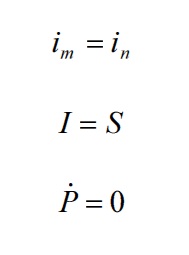Fixing the Economists Article of the Week
by Philip Pilkington
Jan has brought my attention to the following paper which lays out a good outline of Gunnar Myrdal’s Monetary Equilibrium. Since many are unfamiliar with Myrdal’s theories in the English speaking world I will lay out what I think to be some of the most salient points here.

Tobon lays out a nice clear series of conditions that must be met for monetary equilibrium to occur in Wicksell’s theory:

Or, in English:
Wicksell’s monetary equilibrium is defined by three fundamental conditions: 1) the equality between the money interest rate im and the natural interest rate in, 2) the equality between investment I and savings S , and 3) the stability of the general level of prices, that is to say its variation rate in time, P , is equal to zero. (Pp4)
Those familiar with theories such as the New Keynesian Taylor Rule or the Austrian Business Cycle Theory will instantly recognise that the conditions set out at the base of Wicksellian theory also apply to these theories.
In contrast to the three conditions needed for Wicksell’s equilibrium Myrdal lays out three different conditions — which, due to their probably being less familiar to the reader, will have to be explained in more detail. These conditions are as follows:

The first condition is that the price of new capital goods, c2, should be equal to the price of production of these goods, r2. Or, put somewhat differently: that entrepreneurs should not be able to make additional profits by taking advantage of the spread between the price of new capital goods and the price of production of these goods. This, then, is an equilibrium or ‘normal’ profit condition and leads to a constancy of the net investment flow.
The second condition is where all the action lies, as it were. It states that gross real investment, R2, must equal free capital disposal, W. We must understand free capital disposal to mean not simply savings but also expectations regarding the future. Myrdal breaks down W as W = S + D where the D includes expectations about the net change in capital values. Or, as Myrdal put it this value is:
…calculated for the period by taking into consideration all expectations of income and cost for the whole remaining life of the capital goods and also the interest rates which actually rule in the existing situation and are expected to rule in the future. (Pp6)
Here we see something very similar to Keynes’ long-run expectations in the face of uncertainty. What Myrdal is doing is replacing the I = S condition — which in his algebra would be R2 = S — with a term that also captures expectations concerning the future.
This is where the third condition comes in. Unlike in the Wicksellian framework — and also the Austrian framework — Myrdal does not assume that price changes in equilibrium should be zero. According to Myrdal Wicksell inserted this condition based on “sentiment and as a result of a normative, a priori, intuition”. Instead Myrdal allows that there will be some inflationary drift. Thus in his framework the change in prices in equilibrium, P, is a function of a constant, k.
We must then consider the effect that the third conditions — that is, the change in prices through time — has on the second condition. Or, put more simply: what effects variations in the rate of change of the price level have on the expectations of entrepreneurs.
Myrdal then introduces the idea that some prices in the economy are flexible while some are fixed. Thus, when the price level changes the relative price structure changes; fixed prices fall in real terms, while flexible prices rise in real terms relative to said fixed prices. This, according to Myrdal, eliminates the neutrality of money argument that was taken over by Wicksell from the quantity theory of money.
To summarise then, what Myrdal was doing was explicitly introducing expectations into his theory of investment. This is what then allowed him to introduce the notions of ex post and ex ante that I discussed in my previous post. Myrdal then makes these expectations rely on what entrepreneurs expect future price changes to be. But by introducing the idea that some prices may be fixed, different entrepreneurs will experience different changes in real prices and this will affect their future decisions to invest etc.
Myrdal’s theory, then, in some ways resembles certain New Keynesian theories; although it does have the advantage that it has a term, D, that might be interpreted as ‘animal spirits’. Unfortunately, Myrdal never considered the dynamics of the credit-system he introduced. While he did indeed recognise that money is endogenous and not neutral, he never really examined what effects shifts in demand could have on the credit-system and vice versa. He thus never came to appreciate the existence, for example, of debt deflation dynamics as Keynes had in his General Theory.
He also appears, at least at the time of writing Monetary Equilibrium, to have believed in the naive marginalist view of the world where prices are set in line with some sort of utility-calculus and, apart from a few “sticky” prices, the economy adjusts cleanly to changes. But I suppose a similar case could be made for Keynes who certainly did take the neoclassical theory seriously before criticising it on its own terms. Better, I think, to throw out the lot.







